Archaeometric Analyses of dolia of the Final Bronze Age/Early Iron Age Found at Gagliato (CZ)–Calabria–Southern Italy
Abstract
:1. Introduction
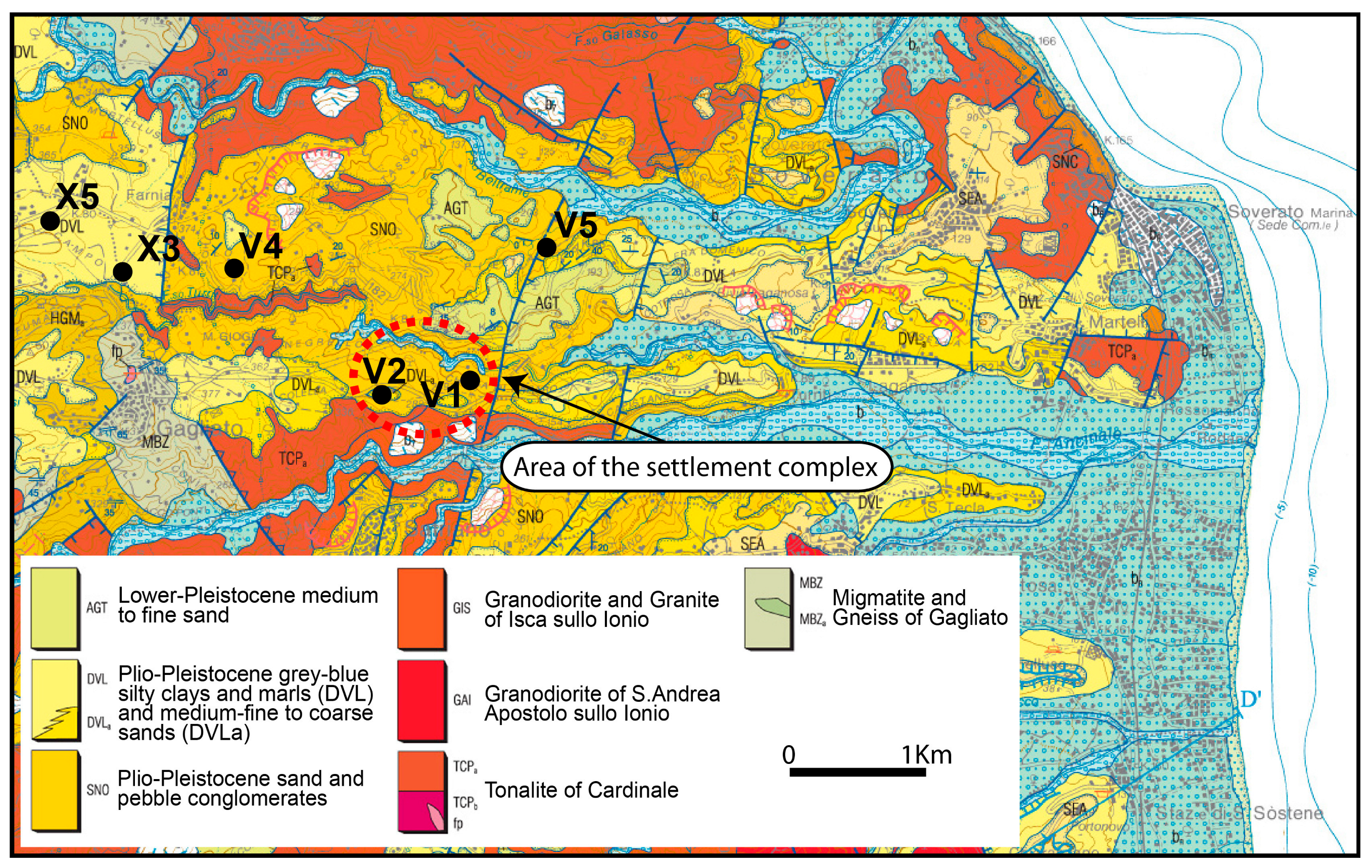
2. Materials and Methods
3. Results
3.1. Petrographic Analysis
3.2. Mineralogical Analysis
3.3. Micropaleontological Analysis
4. Discussion
5. Conclusions
Author Contributions
Funding
Data Availability Statement
Conflicts of Interest
References
- Tucci, A.M. L’età del Bronzo nel Comprensorio di Soverato (CZ), Atti Della XXXVII Riunione Scientifica, Preistoria e Protostoria della Calabria, Scalea, Papasidero, Praia a mare, Tortora, 29 Settembre–4 Ottobre 2002; Istituto Italiano di Preistoria e Protostoria: Florence, Italy, 2004; pp. 843–847. ISBN 978-88-6045-044-9. [Google Scholar]
- Tucci, A.M. L’età del Bronzo Nelle Province di Catanzaro, Vibo Valentia e Crotone. Studi e Materiali di Geografia Storica della Calabria; Givigliano, G.P., Ed.; Due Emme Edizioni: Torre del Greco (NA), Italy, 2002; pp. 3–160. [Google Scholar]
- Aisa, M.G.; Tucci, A.M. Il sito fortificato di Gomeno (Gagliato, CZ) tra età arcaica ed ellenistica. In Centri Fortificati Indigeni della Calabria dalla Protostoria all’età Ellenistica; Atti del Convegno: Napoli, Italy, 2017; pp. 489–491. [Google Scholar]
- Aisa, M.G.; Tucci, A.M. Nuove Prospettive di Ricerca nel Territorio di Gagliato; Deputazione di Storia Patria per la Calabria: Reggio Calabria, Italy, 2014; pp. 101–114. ISSN 0393-022X. [Google Scholar]
- Tucci, A.M. Dolii Protostorici di Impasto dal Territorio di Gagliato (CZ) in Preistoria del cibo. L’alimentazione nella Preistoria e nella Protostoria; Studi di Preistoria e Protostoria Italiana; Damiani, I., Cazzella, A., Copat, V., Eds.; Riunione Scientifica dell’Istituto Italiano di Preistoria e Protostoria: Florence, Italy, 2021; pp. 991–996. ISBN 978-88-6045-088-3. [Google Scholar]
- Levi, S.T. Produzione e Circolazione della Ceramica nella Sibaritide Protostorica, I. Impasto e dolii; Grandi contesti e problemi della protostoria italiana 1, a cura di; Peroni, R., Vanzetti, A., Cazzella, A., Eds.; All’insegna del Giglio: Florence, Italy, 1999; ISBN 9788878141391. [Google Scholar]
- De Francesco, A.M.; Barca, D.; Tucci, A.M.; Scarpelli, R. Provenance study of the protohistoric impasto pithoi in the Soverato area (Calabria-Southern Italy) by LA-ICP–MS analysis of individual biotite grains, Il tempo del pianeta Terra e il tempo dell’uomo: Le geoscienze fra passato e futuro, Abstract Book. In Proceedings of the Congresso SIMP-SGI-SOGEI 2019, Parma, Italy, 16–19 September 2019; p. 166. [Google Scholar] [CrossRef]
- Paglionco, A.; Festa, V. Note Illustrative Carta Geologica d’Italia ISPRA Foglio 580-Soverato; ISPRA, Servizio Geologico d’Italia: Rome, Italy, 2015. [Google Scholar]
- Ortolano, G.; Pagano, M.; Visalli, R.; Angì, G.; D’Agostino, A.; Muto, F.; Critelli, S.; Cirrincione, R. Geology and structure of the Serre Massif upper crust: A look into the late-Variscan strike–slip kinematics of the southern European Variscan chain. J. Maps 2022, 18, 314–330. [Google Scholar] [CrossRef]
- Russo, D.; Fiannacca, P.; Fazio, E.; Cirrincione, R.; Mamtani, M.A. From floor to roof of a batholith: Geology and petrography of the north-eastern Serre Batholith (Calabria, southern Italy). J. Maps 2022, 19, 2149358. [Google Scholar] [CrossRef]
- Lirer, F.; Foresi, L.M.; Iaccarino, S.M.; Salvatorini, G.; Turco, E.; Cosentino, C.; Sierro, F.J.; Caruso, A. Mediterranean Neogene planktonic foraminifer biozonation and biocronology. Earth Sci. Rev. 2019, 196, 102869. [Google Scholar] [CrossRef]
- Rathossi, C.; Pontikes, Y. Effect of Firing Temperature and Atmosphere on Ceramics Made of Nw Peloponnese Clay Sediments. Part I: Reaction Paths, Crystalline Phases, Microstructure and colour. J. Eur. Ceram. Soc. It. 2010, 30, 1841–1851. [Google Scholar] [CrossRef]
- Whitbread, I.K. Greek Transport Amphorae: A Petrological and Archaeological Study; British School at Athens, Fitch Laboratory Occasional Paper 4: Athens, Greece, 1995. [Google Scholar]
- Maggetti, M.; Neururer, C.; Ramseyer, D. Temperature evolution inside a pot during experimental surface (bonfire) firing. Appl. Clay Sc. 2011, 53, 500–508. [Google Scholar] [CrossRef]
- Maniatis, Y.; Tite, M.S. Technological examination of Neolithic–Bronze Age pottery from central and southeast Europe and from the Near East. J. Archaeol. Sci. 1981, 8, 59–76. [Google Scholar] [CrossRef]
- Cultrone, G.; Rodriguez-Navarro, C.; Sebastian, E.; Cazalla, O.; De La Torre, M.J. Carbonate and silicate phase reactions during ceramic firing. Eur. J. Mineral. 2001, 13, 621–634. [Google Scholar] [CrossRef]
- Maritan, L.; Nodari, L.; Mazzoli, C.; Milano, A.; Russo, U. Influence of firing conditions on ceramic products: Experimental study on clay rich in organic matter. Appl. Clay Sc. 2006, 31, 1–15. [Google Scholar] [CrossRef]
- Riccardi, M.P.; Messiga, B.; Duminuco, P. An Approach to the Dynamics of Clay Firing. Appl. Clay Sc. 1999, 15, 393–409. [Google Scholar] [CrossRef]
- Maritan, L.; Mazzoli, C.; Freestone, I. Modelling Changes in Mollusc Shell Internal Microstructure during firing: Implications for Temperature Estimation in Shell-Bearing Pottery. Archaeometry 2007, 49, 529–541. [Google Scholar] [CrossRef]
- Privitera, A.; Guido, A.; Mastandrea, A.; Rao, A.; Russo, F. Morphological and mineralogical evolution of microfossils during the heating process: A contribution to the archaeometric study of ceramics. Rend. Fis. Acc. Lincei 2015, 26, 499–512. [Google Scholar] [CrossRef]
- Daghmehchi, M.; Guido, A.; Mastandrea, A.; Salahi, M.A.; Omrani, M.; Nokandeh, J. Thermal analysis of ancient ceramics using the microchemical and microstructural alterations of foraminifera. Mater. Charact. 2017, 130, 81–91. [Google Scholar] [CrossRef]
- Flugel, E. Microfacies of Carbonate Rocks, Analysis, Interpretation and Application; Springer: Berlin/Heidelberg, Germany; New York, NY, USA, 2004. [Google Scholar]
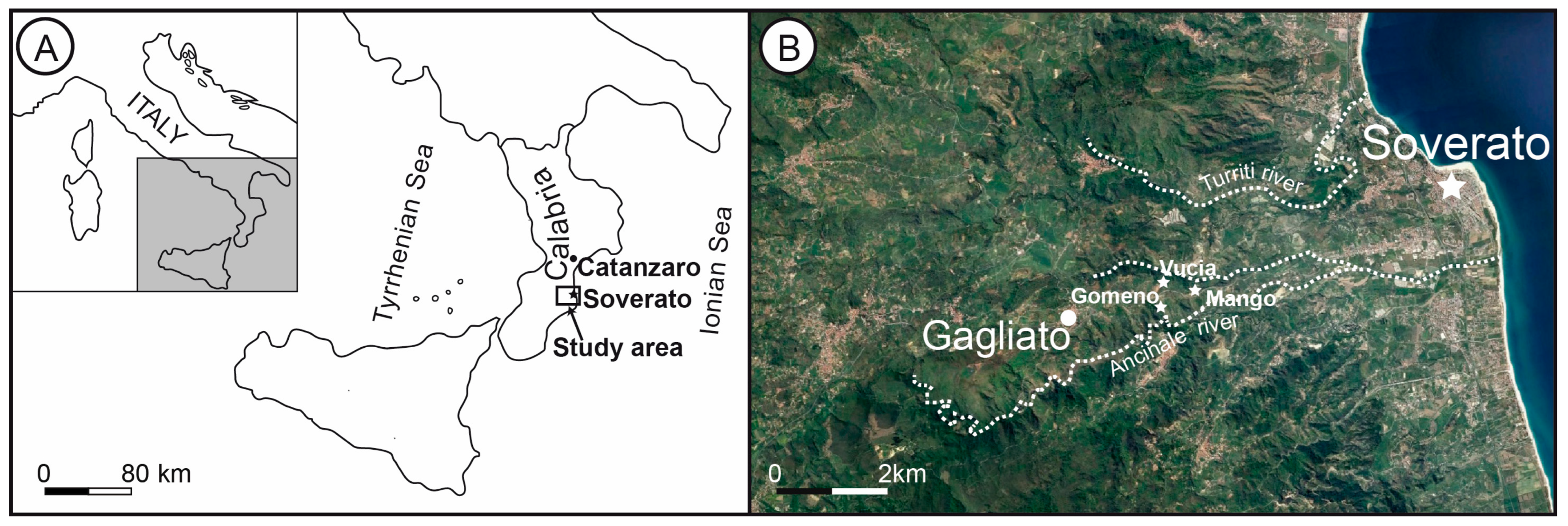
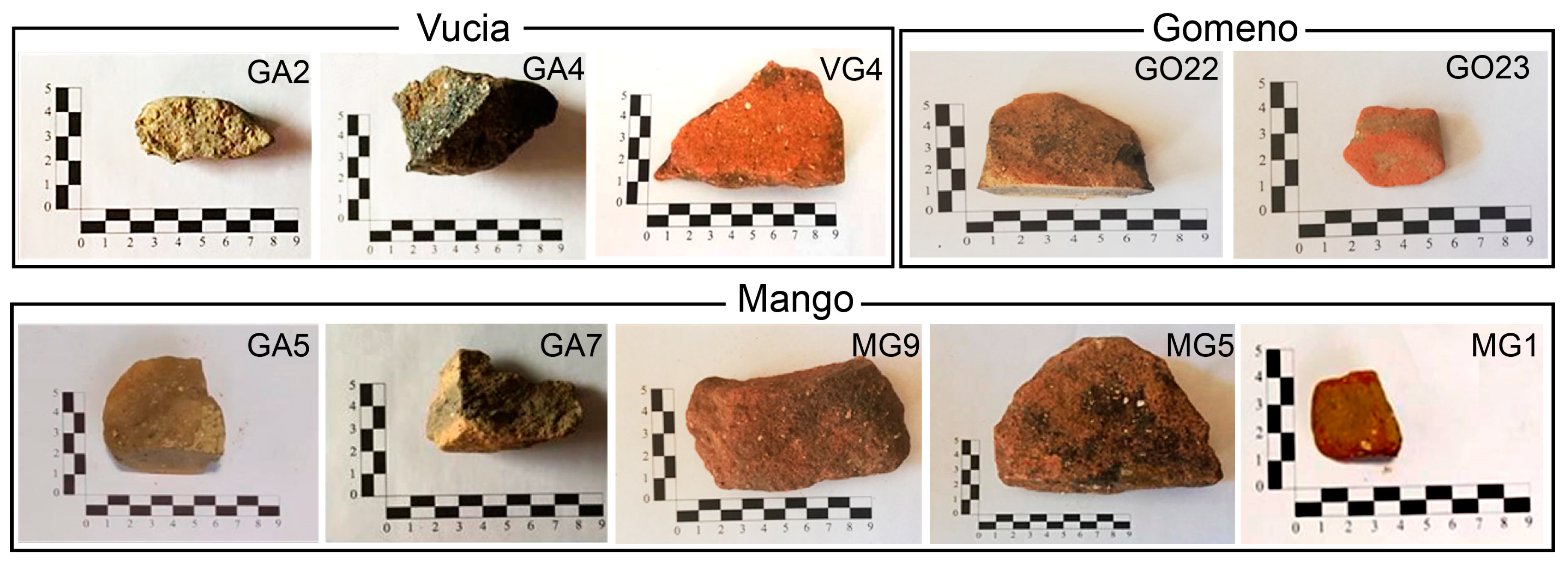
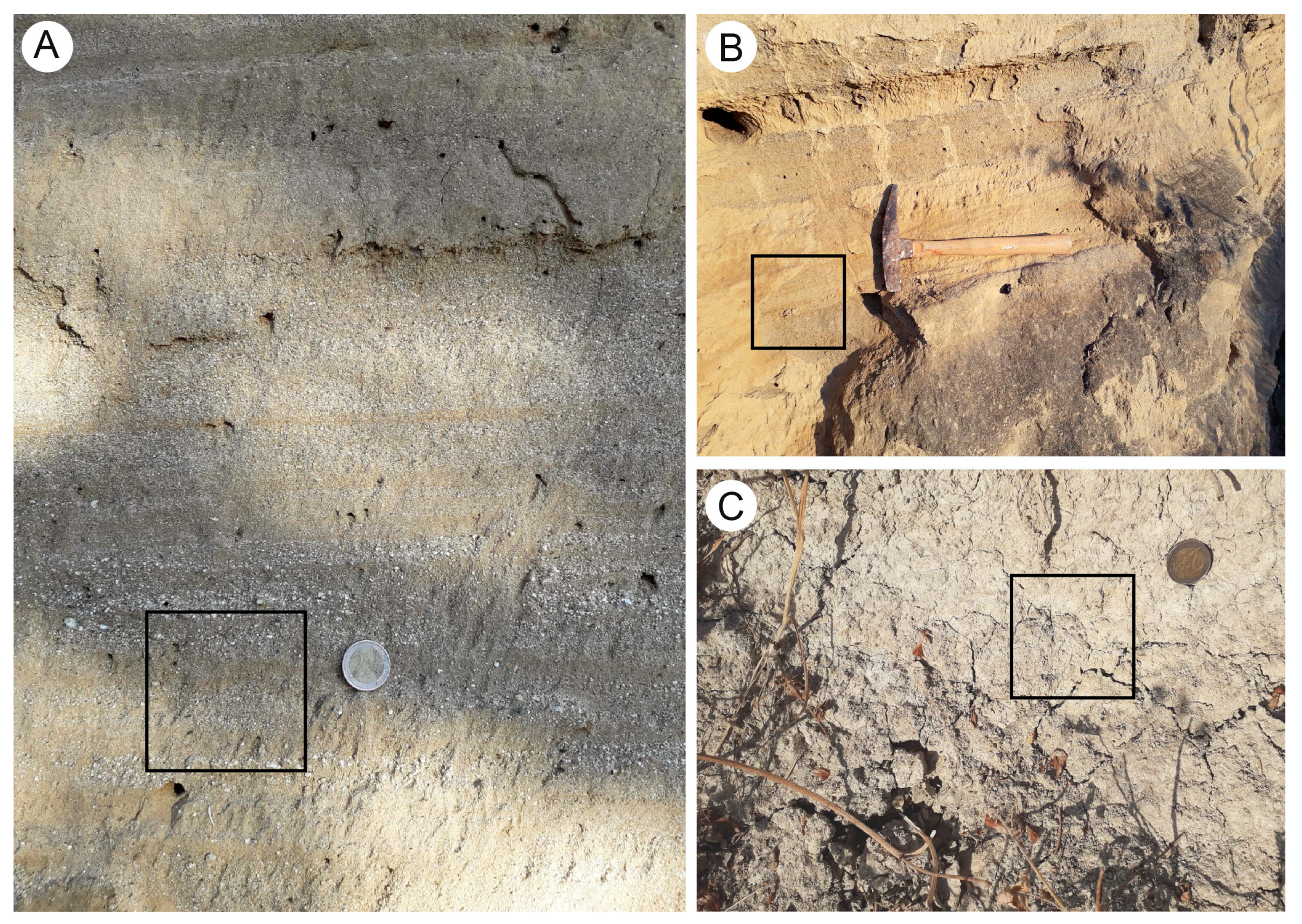
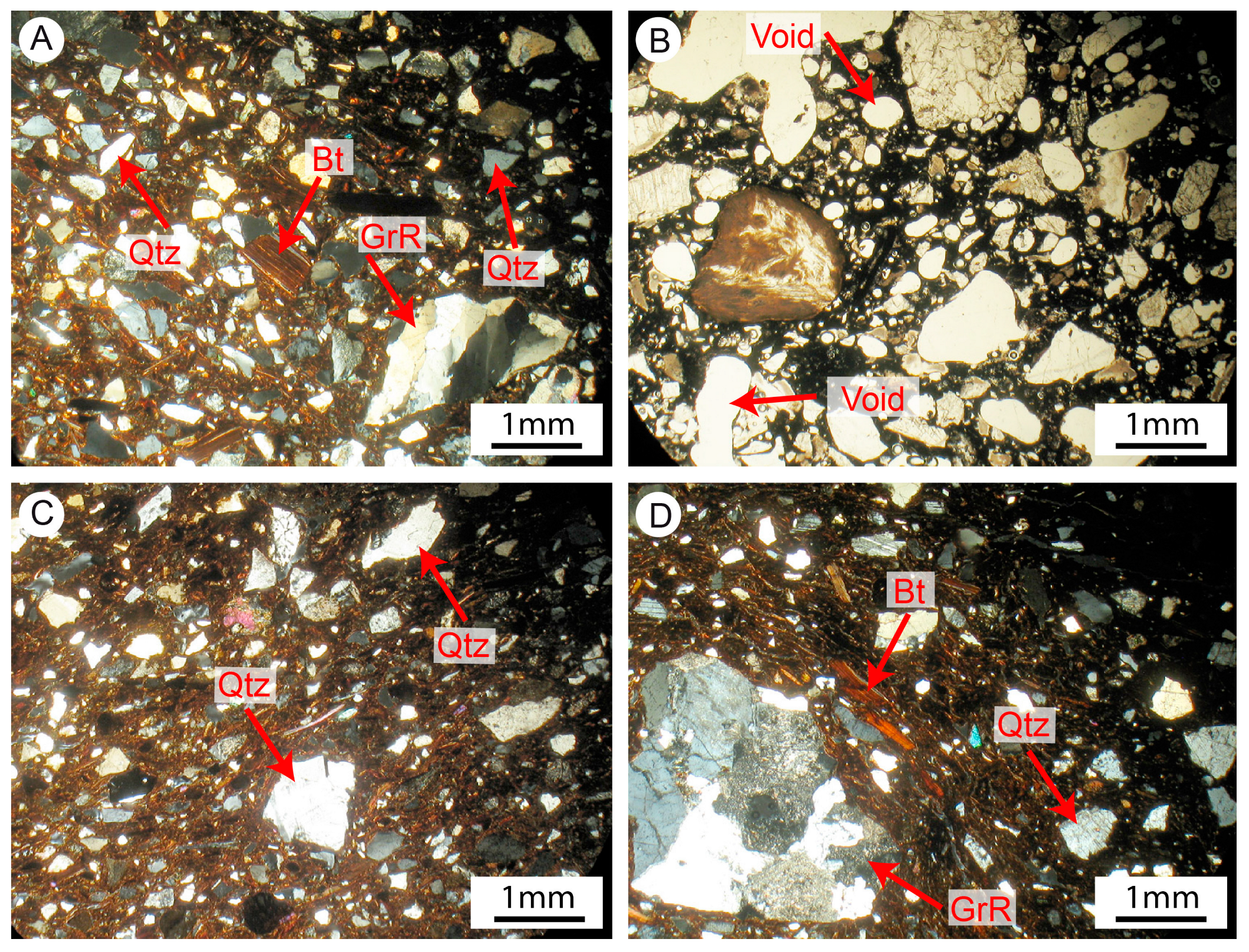
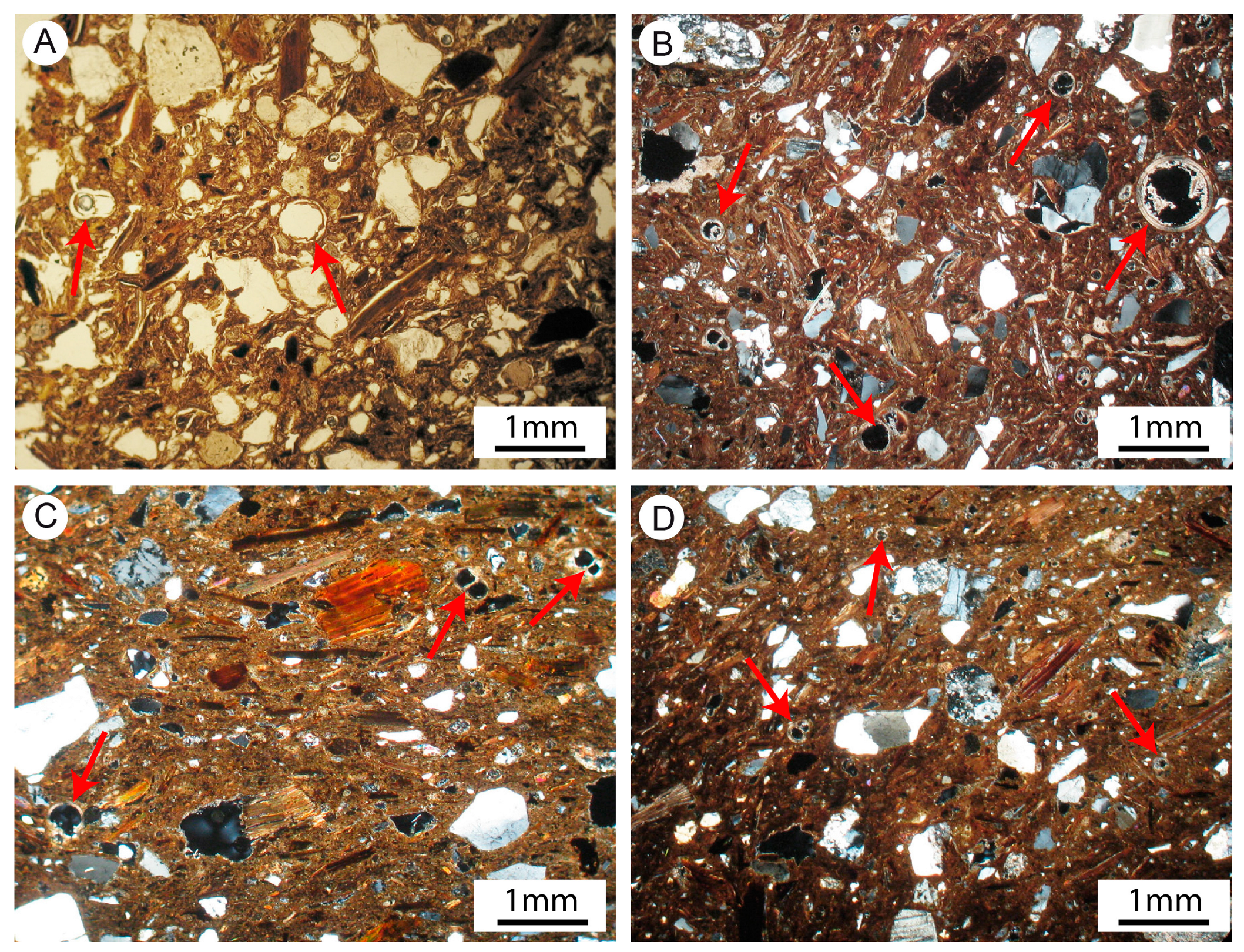
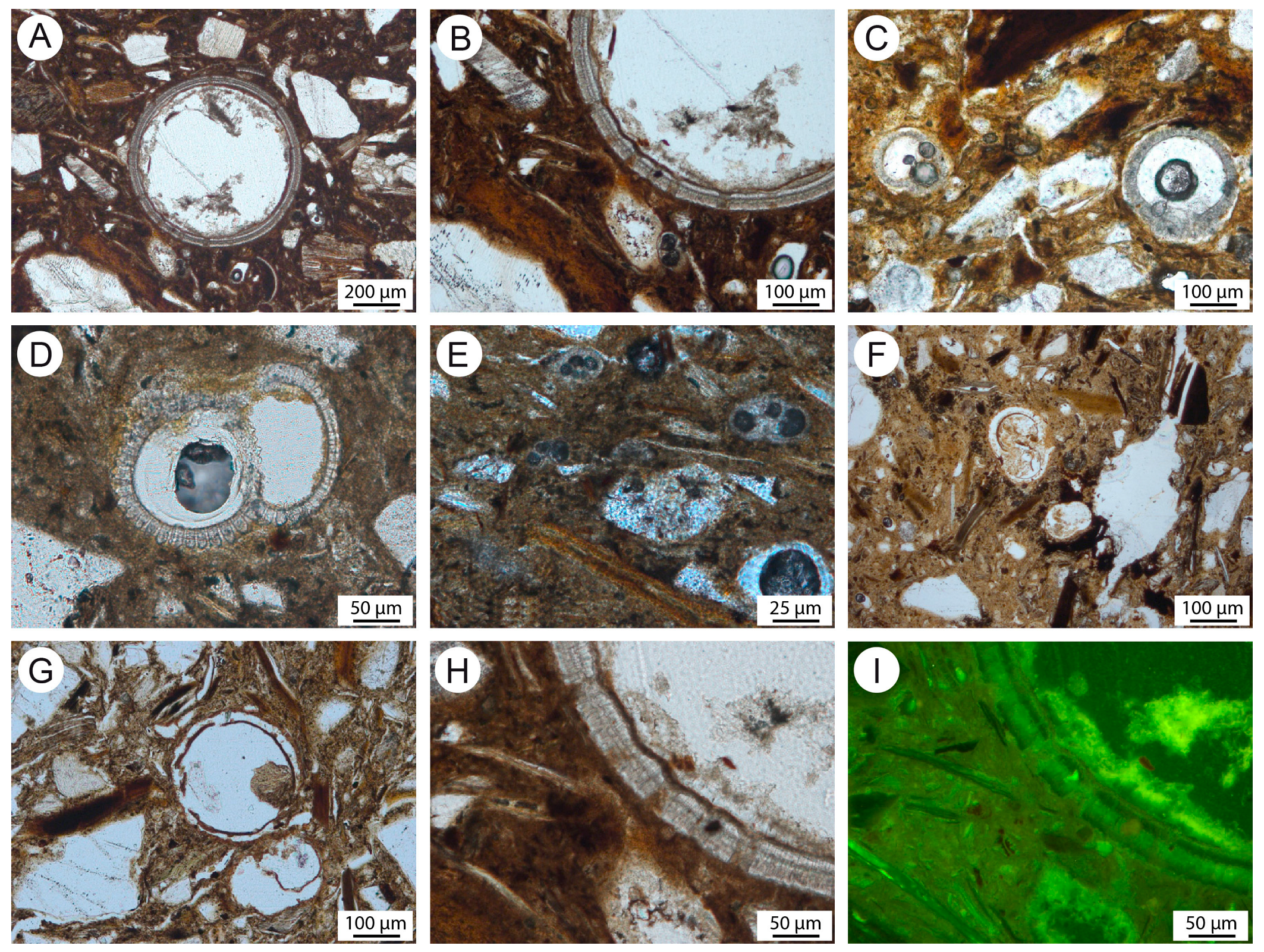
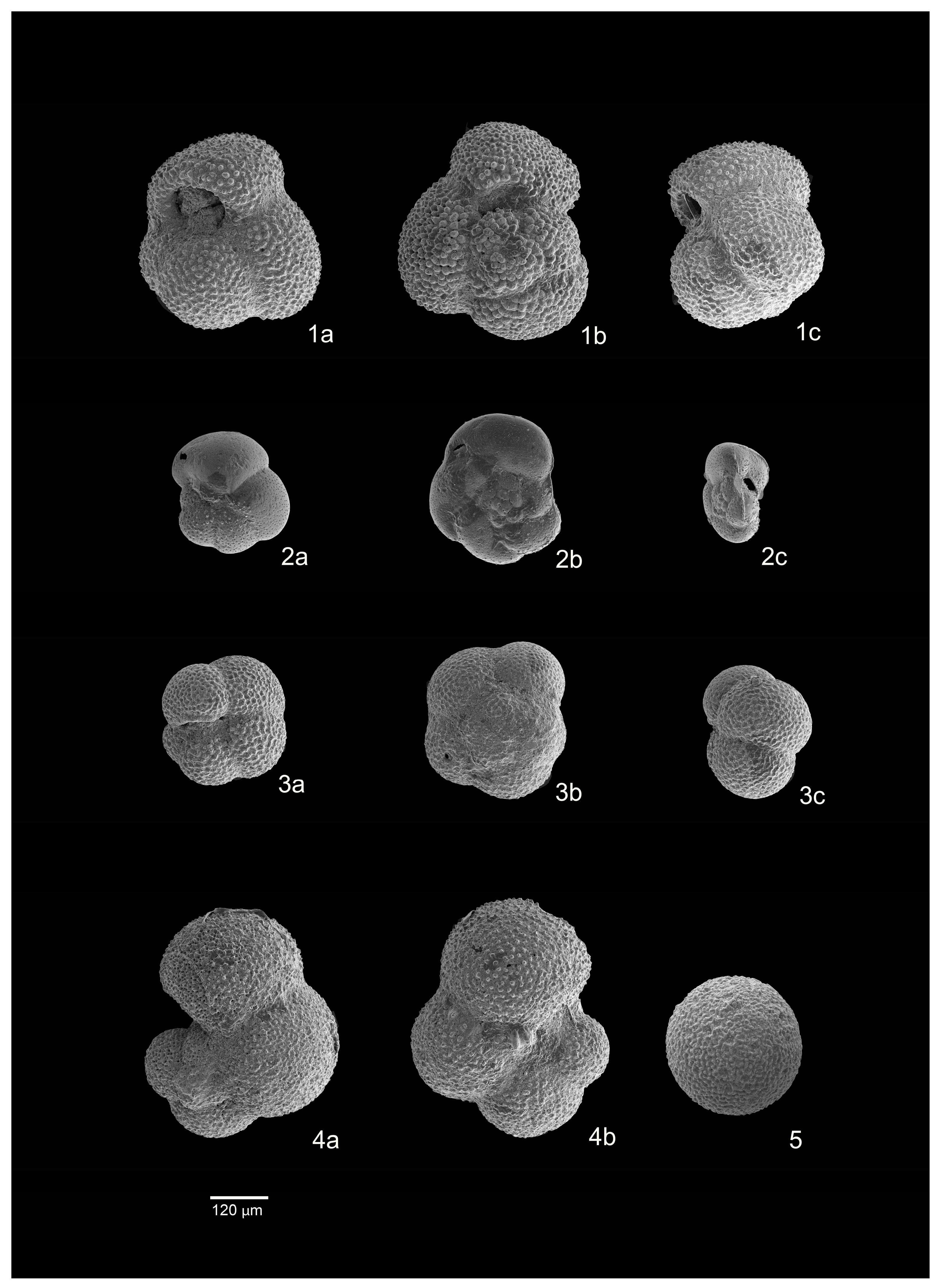
| Dolia Samples | Locality | Type |
|---|---|---|
| First group | ||
| GA2 | Vucia | Small vertical stick handle [5: Figure 3.6]. |
| GA3 | Vucia | Small vertical stick handle [5: Figure 3.5]. |
| GA4 | Vucia | Fragment deformed by heat [Tucci 2006: 16]. |
| GO17 | Vucia | Shoulder decorated with herringbone pattern [5: Figure 3.10]. |
| VG4 | Vucia | Short truncated conical neck; rim with traces on the surface of wheel-fashioning technique [5: Figure 2.7]. |
| GO23 | Gomeno | Bottom of a dolium. |
| MG9 | Mango | Flattened rim with enlarged and squared internal and external margins [5: Figure 2.12]. |
| Second group | ||
| GA1 | Mango | Concave bottom with triangular decoration [5: Figure 2.1]. |
| GA5 | Mango | Banded rim with triangular decoration [5: Figure 2.1]. |
| GA7 | Mango | Circular support with triangular decoration [5: Figure 3.3]. |
| MG1 | Mango | Brimmed edge [5: Figure 2.5]. |
| MG5 | Mango | Brimmed rim and narrow mouth [5: Figure 2.9]. |
| GO20 | Mango | Rim of globular to ovoid dolium body [5: Figure 2.4]. |
| GO22 | Gomeno | Bottom of a dolium [4: Figure 4]. |
| Geological samples | GPS Lat. Long. | Sediment |
| X3 | 38.68573 16.46064 | Clay—Plio-Pleistocene grey-blue silty clays and marls (DVL in the geological map Figure 2 and Figure 4) |
| X5 | 38.69936 16.45578 | Clay—Plio-Pleistocene grey-blue silty clays and marls (DVL in the geological map Figure 2 and Figure 4) |
| V1 | 38.67866 16.48318 | Sand and conglomerate—Plio-Pleistocene sand and pebble conglomerates (SNO in the geological map Figure 2 and Figure 4) |
| V2 | 38.67747 16.48213 | Sand—Plio-Pleistocene medium-fine to coarse sands (DVLa in the geological map Figure 2 and Figure 4) |
| V4 | 38.68656 16.46803 | Sand and conglomerate—Plio-Pleistocene sand and pebble conglomerates (SNO in the geological map Figure 2 and Figure 4) |
| V5 | 38.68769 16.49667 | Sand and conglomerate—Plio-Pleistocene sand and pebble conglomerates (SNO in the geological map Figure 2 and Figure 4) |
| Ceramics | Group | Qtz | Pl | Bt | Kf | Cal | Di | |||
|---|---|---|---|---|---|---|---|---|---|---|
| GAGLIATO | MANGO | GA1 | 2 | *** | ** | ** | * | - | Tr | |
| GA5 | 2 | **** | ** | ** | * | ** | - | |||
| GA7 | 2 | **** | ** | *** | * | - | Tr | |||
| MG5 | 2 | **** | *** | *** | ** | * | - | |||
| GO20 | 2 | **** | ** | ** | * | * | - | |||
| VUCIA | GO17 | 1 | **** | ** | ** | * | - | - | ||
| VG4 | 1 | **** | * | ** | * | - | - | |||
| sediments | Qz | Pl | Bt | Kf | Illite | Cal | Chl | |||
| V1 | **** | *** | * | * | * | * | ||||
| V4 | **** | *** | * | * | * | * | ||||
| V5 | **** | *** | * | * | * | * | ||||
| X3 | ** | - | - | - | Tr | **** | Tr | |||
| X5 | ** | - | - | - | ** | **** | ** |
Disclaimer/Publisher’s Note: The statements, opinions and data contained in all publications are solely those of the individual author(s) and contributor(s) and not of MDPI and/or the editor(s). MDPI and/or the editor(s) disclaim responsibility for any injury to people or property resulting from any ideas, methods, instructions or products referred to in the content. |
© 2023 by the authors. Licensee MDPI, Basel, Switzerland. This article is an open access article distributed under the terms and conditions of the Creative Commons Attribution (CC BY) license (https://creativecommons.org/licenses/by/4.0/).
Share and Cite
De Francesco, A.M.; Tucci, A.M.; Guido, A.; Rao, A.; Barca, D. Archaeometric Analyses of dolia of the Final Bronze Age/Early Iron Age Found at Gagliato (CZ)–Calabria–Southern Italy. Minerals 2023, 13, 1422. https://doi.org/10.3390/min13111422
De Francesco AM, Tucci AM, Guido A, Rao A, Barca D. Archaeometric Analyses of dolia of the Final Bronze Age/Early Iron Age Found at Gagliato (CZ)–Calabria–Southern Italy. Minerals. 2023; 13(11):1422. https://doi.org/10.3390/min13111422
Chicago/Turabian StyleDe Francesco, Anna Maria, Antonina Maria Tucci, Adriano Guido, Anna Rao, and Donatella Barca. 2023. "Archaeometric Analyses of dolia of the Final Bronze Age/Early Iron Age Found at Gagliato (CZ)–Calabria–Southern Italy" Minerals 13, no. 11: 1422. https://doi.org/10.3390/min13111422
APA StyleDe Francesco, A. M., Tucci, A. M., Guido, A., Rao, A., & Barca, D. (2023). Archaeometric Analyses of dolia of the Final Bronze Age/Early Iron Age Found at Gagliato (CZ)–Calabria–Southern Italy. Minerals, 13(11), 1422. https://doi.org/10.3390/min13111422








